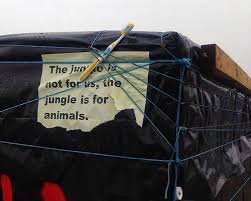It goes without saying the camp known as the Jungle in Calais prompts a lot of different reactions. This is just a small part of my own:
I spend a lot of time writing about the Jungle camp in Calais. Talk about the camp is almost impossible to avoid, particularly if you’re a journalist,and much of it isn’t good.
From reading and writing about the camp for the past few months, I had an impression of it as muddy, miserable, bleak, full of people who can’t wait to ‘break into Britain’ and who mug journalists filming reports.
I knew some things, I knew there were barbershops there, restaurants, even a disco. But it was ridiculous that I had no idea what it was actually like and relying on media reports can be pointless because they all have an agenda.
Sitting in a car, driving to the camp for the first time with two friends and some other volunteers, it’s difficult to shake the worry that you’re only here for ‘disaster tourism’. Like when people go on holiday to Auschwitz, or to Ground Zero.
But why do we go on holiday to places? For most people it’s too see them, reading about other cities and countries isn’t good enough so we want to know what it’s like for ourselves.
For me it’s to gain a sense of reality, and the same goes for ‘disaster’ places. Reading about the camp is fine but it’s almost impossible for us to imagine, by reading, that there is actually a giant muddy camp full of people sitting just across the Channel. That was why I went, to get a sense of the reality. Maybe it is so-called disaster tourism, but by having seen it for myself now I don’t have to rely on other people’s accounts.
I also visit places to try to meet the people who live there, to meet ‘other’ people. Until you talk to someone who lives there, a new city is always intimidating, it always feels like it’s a solid unit and you’re outside of it, for me anyway. It’s another idea that you can’t shake if you’re only impression is in the media. The ‘refugees’ or ‘migrants’ or ‘asylum seekers’; a great wave of people battering against the shores of Britain. They aren’t individuals, because it’s impossible to get an idea of individuality across in a media report. In the media, one person from a group, if involved in a crime, acts for the whole crowd. It’s the crowd that’s intimidating.
We went to the camp first to distribute ‘goody bags’. They’re filled with things like toothpaste and toilet roll. We had a bit of a trial run before leaving the warehouse, to make sure everyone knew their roles and what to expect. Someone was inside the van, two people were handing out bags, one was ‘gate’ to meet people and control the queue at the front, two people either side held hands to form a funnel into the van (my role), and two more people stood further down the queue to check for scuffles.
The people living in the camp are well used to the system. As soon as we pulled up a line formed, weirdly it seemed like a game, with everyone saying ‘Line, line’ and laughing. We’d been told to smile, talk to people, to make sure people didn’t feel ashamed to come to the van and take a bag.
But even so, I was nervous when faced with a long queue of men – in the whole time I maybe saw six women from a distance, and a handful of children – and I was shy to make eye contact and start chatting. A couple of scuffles broke out further down the line, but it was only when people tried to skip the queue. Immediately cries of ‘Line, line’ would start and a volunteer would step in to make sure the system was stuck to.
Reports about the camp often use words like ‘chaotic’. But that’s not what I saw. There are streets, lined with shops and places to eat. Around them are the residential areas, where people have put up tents and built small homes with wooden frames and tarpaulin. In a lawless place people have created a system; with no design, where chaos could reign instead people have built a working town.
I went to Calais with a friend who is writing a play about anarchy, it was on his mind both in the camp and at the warehouse. I think after seeing both the camp and warehouse and how they operate, he’s been forced to change his ideas of what anarchy is and how it functions. Both places operate without rules – beyond the basic health and safety rules in the warehouse. I still couldn’t tell you who was in charge in the warehouse, but I don’t think I’ve ever seen a group of people work together so productively.
Within minutes a lorry-load of donations would be cleared, sorted into boxes by a group of people who have never met before, with no one issuing instructions. From talking to other volunteers, no one is a permanent fixture in the warehouse, even those who claim to have been there the longest have only been there a month or so. But after just a couple of hours everyone feels like they’ve learnt the system without being taught it. Human chains passing boxes along formed from nowhere, and as soon as the job was done the chain would dissipate to find something new to do.
It might sound odd, but I’ve come back to London with a sense of goodness and optimism about people. People in the camp and people in the warehouse are working together for a common good and – despite the obvious hardships for the people living in the camp – it’s been a while since I’ve been somewhere that felt so positive.

